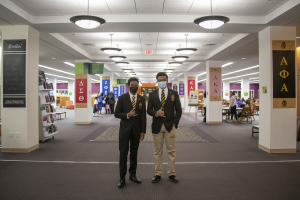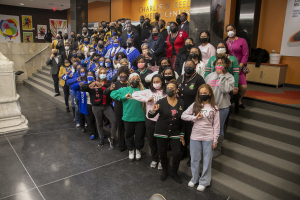Tuesday, Feb. 1, William & Mary Libraries celebrated the opening of its latest exhibit, “Strollin’: A History of Black Greek Letter Organizations at William & Mary.” The opening featured a discussion with Wake Forest University Law Professor Gregory Parks, author of A Pledge with Purpose: Black Sororities and Fraternities and the Fight for Equality.
“Strollin’” traces the history of Black fraternities and sororities at the College of William & Mary, starting in 1975 with the founding of the Kappa Pi chapter of Alpha Phi Alpha, Inc. Historical artifacts, photos and informational plaques will be on display in the Marshall Gallery of Earl Gregg Swem Library until Aug. 31, 2022.
Exhibit curator and the College’s oral historian, Andre Taylor, focused on integrating spoken narratives into “Strollin’.” On the pillars leading into the Marshall Gallery hang the flags of the Divine Nine (D9) Greek letter organizations. Each flag, except Iota Phi Theta — for which the College does not have a chapter — is accompanied by various QR codes linked to videos of alumni sharing their experiences as members of the Greek letter organizations.

In one oral history, Arman Jones ’20 explained how Alpha Delta Sigma, Inc.’s values of male scholarship, perseverance and uplift attracted him to the organization. Jones was particularly interested in uplifting Black culture, which he noticed faced many institutional barriers in the College.
“When I started understanding more about just Greek fraternity in general and the D9, I wanted to help the community, help the Black community specifically at William and Mary,” Jones said.
Taylor believes that this exhibit is necessary considering the larger context of Greek organizations on campus. In 1776, Phi Beta Kappa was founded at the College as the first fraternity in America.
“William and Mary is the epicenter for the Greek life in America,” Taylor said. “It’s important that we tell our story because Black Greek letter organizations arrived on William and Mary almost 200 years after the arrival of Phi Beta Kappa.”
“William and Mary is the epicenter for the Greek life in America,” Taylor said. “It’s important that we tell our story because Black Greek letter organizations arrived on William and Mary almost 200 years after the arrival of Phi Beta Kappa.”
Assistant Dean and Director of the Center for Student Diversity Kimberly Weatherly, who is an active member of Alpha Kappa Alpha Inc., reiterated the importance of telling this history at the College.
“A lot of times at predominantly-white institutions, you don’t have the history of the Black fraternities and sororities,” Weatherly said. “Hearing the different testimonies from people who were here at William and Mary and their experiences on campus was very enlightening.”
Lamenting how Black Greek letter organizations receive less recognition than their white counterparts, Weatherly also pointed out some of the features that make D9 unique.
“At a lot of other fraternities and sororities, when you pledge you kind of leave that there in undergrad, but when we make that commitment, it’s lifelong,” Weatherly said.
Along with commitment, many D9 organizations emphasize service, curiosity and culture.
“It’s important to understand that these spaces exist to promote educational success but also to promote cultural heritage sharing,” Taylor said. “And that’s very important for me for people to have spaces where they can celebrate their cultural heritage collectively.”
Parks also discussed these themes in the presentation of his book. He began by exploring the origins of Black Greek organizations and their roots in Black churches, secret societies and literary societies. According to Parks, these groups were founded to promote racial uplift, intellectual curiosity and community.
While many of the D9 organizations originated on HBCU campuses, Parks highlighted the unique significance of those formed at predominantly-white institutions such as the College.
“The dynamics that black students experienced at those institutions then, and ironically, in many ways, still to that today is a spirit or a feeling of isolation, lack of connection,” Parks said. “‘Society offered us narrowly circumscribed opportunity and no security. Out of our need, our fraternity brought social purpose and social action’,” Parks said, quoting Henry Arthur Callis, a founder of Alpha Phi Alpha, Inc..
Black Greek organizations were formed to support the struggle of Black Americans. Now 100 years later, activism and service remain key tenets of many of these groups. For Shiyanna McLeod ’23, the “Strollin’” exhibit effectively emphasizes this.
“We do a lot for our communities that sometimes goes unseen,” McLeod said. “Most of, if not all of the Black Greek letter organizations are service-based and that’s something that’s not necessarily highlighted.”

Parks explained some of this history, recognizing how the D9’s efforts to promote racial uplift are not as well-known as those of traditional civil rights groups. He spoke about the American Council on Human Rights, a collective of six Greek letter organizations focused on issues such as education, healthcare and voting rights.
“Where there’s progress there’s always retrenchment; where there’s advancement there’s always folks who want to push back on that advancement,” Parks said. “The important thing about this book isn’t really the history we’re looking at, the important thing for me is that it begs the question, what are we going to do today?”
When Parks opened the floor up for questions, he was asked about issues including recent bomb threats at HBCUs, protecting Black youth and dealing with violence. With each of these heavy topics, Parks made a similar call to action.
“Our organizations have some of the most brilliant, talented, committed and wealthy Black folks in this country and I believe that it is time for us as a collective to get serious about the threats at our door,” Parks said.
“Our organizations have some of the most brilliant, talented, committed and wealthy Black folks in this country and I believe that it is time for us as a collective to get serious about the threats at our door,” Parks said.
Parks continually returned to the value of the collective community—both in its ability to provide a space of inclusion and its power to create change. That sense of community was clearly on display during Parks’s discussion. Students, alumni and even those with no connection to the College sat before him, sporting bright colors and embroidered sweaters in celebration of their organizations.
For Taylor, who was wearing a black-and-gold Alpha Phi Alpha, Inc. suit, these people are the reason for the exhibit.
“The exhibit is not about my story, and my journey, and my fraternity, it’s about their journey on this campus,” Taylor said.


[…] Tammy Gordon’s HI 588: Family and Community History class. He also curated the exhibit “Strollin’: A History of Black Greek Letter Organizations at William & Mary” which explores the history of Black sororities and fraternities at William and Mary from 1975 to […]